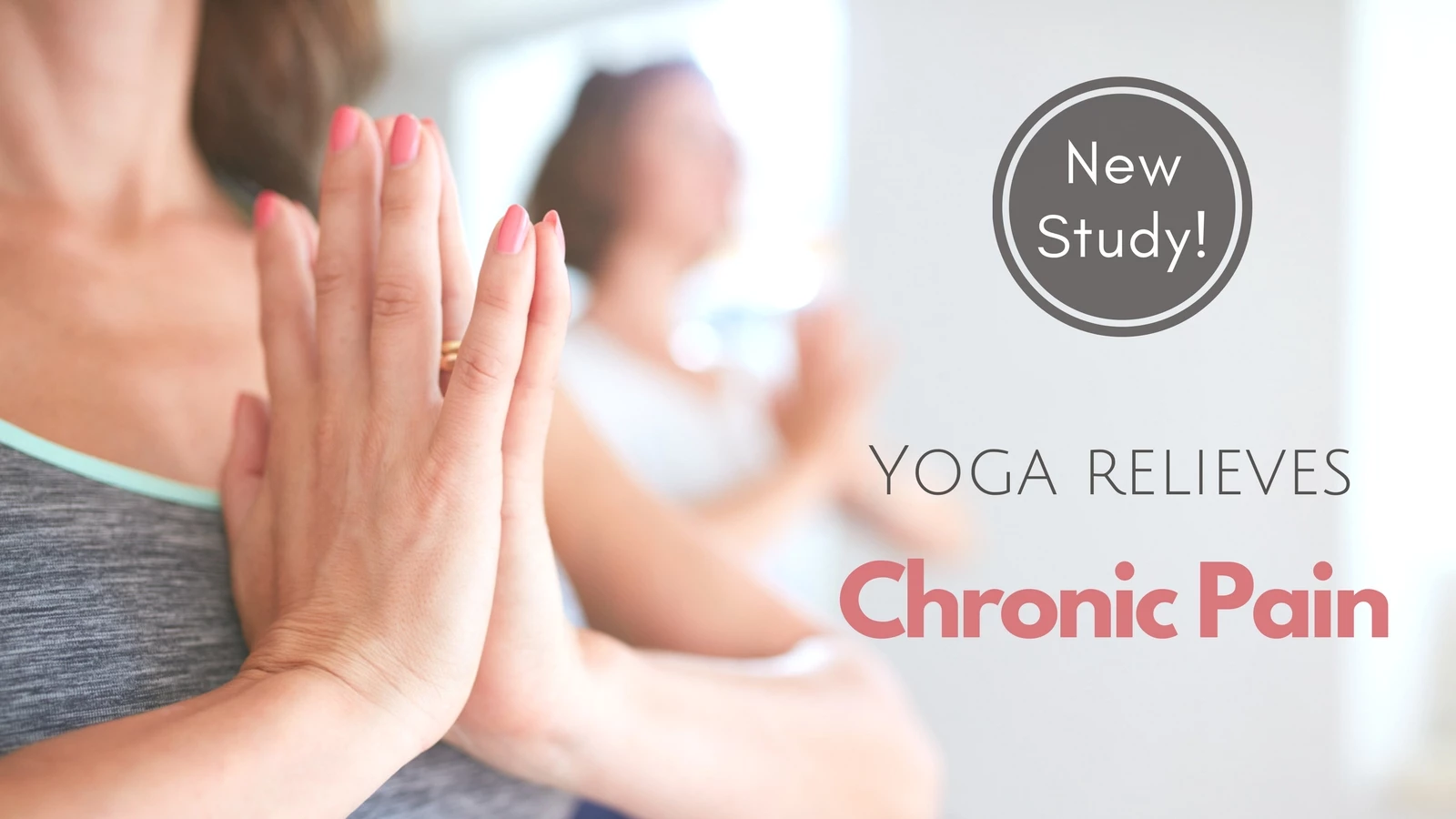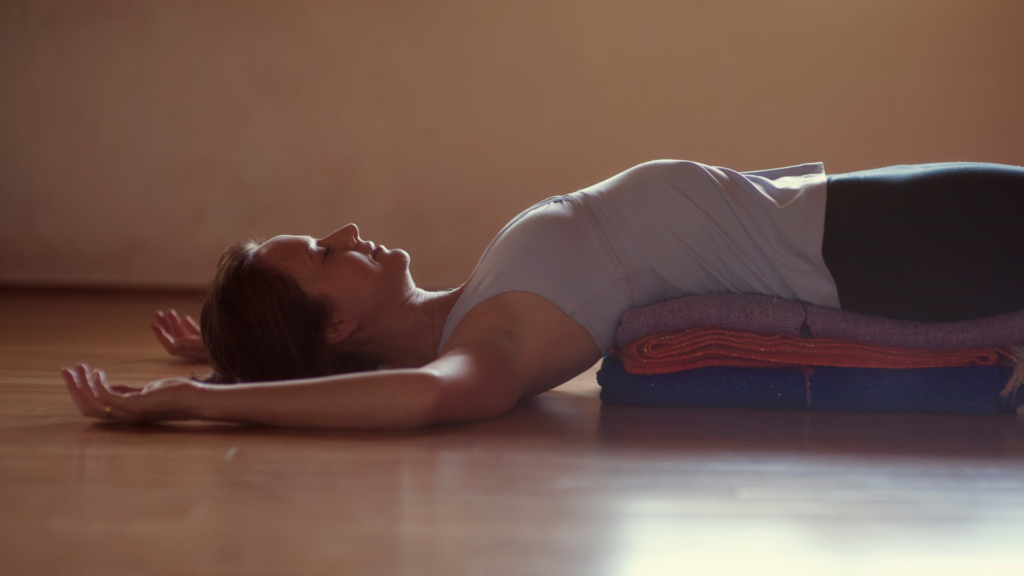Yoga for Pain Relief: Yoga Offers Effective Relief for Chronic Pain

Article At A Glance
What does the research say about yoga for pain relief? Chronic pain affects 126 million American adults annually, leaving many seeking more effective alternatives than standard medication. Thankfully, yoga offers safe and effective options for pain relief, providing hope for those aiming to reduce reliance on painkillers and pharmaceutical treatments. Read on to learn the science behind yoga’s potential for relieving pain for millions.
What does the science say about yoga for pain relief? Chronic pain is one of the most common afflictions impacting American adults, with 126 million of us experiencing persistent, recurring, often severe, and debilitating pain every year. Standard pain care, often consisting of medication, tends to provide only partial or temporary benefits.
Also, with addiction to opiate painkillers reaching staggering proportions, health providers and consumers are more actively seeking complementary approaches like yoga for pain relief. A new review of the evidence published in Mayo Clinical Proceedings, suggests that yoga may play an important role as an effective antidote, particularly for back pain.
Among adults in the U.S., back pain (28%), joint/arthritis pain (21%), neck pain (14%), and headaches (14%) are among the most common. To deal with this pain, a 2012 national survey suggests that a large proportion of Americans (30-40%) turn to some form of complementary care such as yoga, tai chi, and qigong (10.1% combined) meditation (8%), massage therapy, acupuncture, and manipulation (16.6% combined), and natural products or supplements (17.7%) in any given year. These complementary approaches are most often used to manage back pain (14.3 million), neck pain (5 million), and arthritis pain (3.1 million).
Due to this extensive use of complementary approaches, a group of researchers from the National Center for Complementary and Integrative Health reviewed the clinical research to see which approaches might be best suited for primary care patients presenting with back, neck, and joint pain and fibromyalgia.
To do so they examined all of the randomized controlled trials (RCTs) published from January 1, 1966, through March 31, 2016. To make findings relevant to US primary care providers, these studies were limited to trials either conducted in the US, or including American participants.
Yoga May Relieve Chronic Low Back Pain

A total of 6 RCTs were identified in which yoga was used to relieve low back pain. For purposes of their review, yoga was defined as a mind and body practice with origins in ancient Indian philosophy in which techniques such as physical postures, breathing techniques, and meditation or relaxation were combined.
These studies included 596 adults (mostly female) who attended group classes of 60-90 minutes in duration in which either Hatha, Viniyoga or iyengar yoga was offered. The number of sessions ranged from 12 to 24, with classes being held either once or twice a week and home practice often being recommended.
When compared with usual care, two studies suggested that yoga was associated with improvements in pain and function. However, these results varied when comparing yoga with exercise or stretching. Three additional studies found that yoga was linked with modest reductions in pain and functional disability compared to a waitlist or educational control group. No adverse events were reported.
Massage and Manipulation May Reduce Neck Pain
To date, there are no RCTs examining the effectiveness of yoga for relieving chronic neck pain. Of the studies using complementary approaches, 4 assessed the use of massage to relieve neck pain and disability. In one study, adult participants randomized to 10 massage therapy sessions over 10 weeks reported significant improvements in neck pain and disability compared to a no-treatment control group.
Similarly, other studies showed that regular massage sessions were associated with improvements, with greater benefits demonstrated for those who received 60-minute sessions 2 to 3 times per week compared to those who attended weekly sessions.
Of the three studies in which spinal manipulation was tested as an intervention for neck pain, findings were mixed, with some studies reporting improvements following spinal manipulation, while others found little to no effect.
Yoga Linked to Reduced Knee Pain Associated with Osteoarthritis
Only one, quasi-experimental trial of the effects of seated yoga on osteoarthritic knee pain has been published to date. Participants were elderly adults (mean age 80 years of age), and predominantly men (68.7%). Compared to a convenience sample of matched controls assigned to either a Reiki or an attention intervention, yoga group individuals reported substantially better reductions in pain, stiffness, and functional disability. No adverse events were reported in this study.
Yoga Helps in the Management of Fibromyalgia

A single study of 53 women (average age 53.7 years, 92.5% white) compared the effectiveness of yoga for relieving fibromyalgia symptoms compared to a waitlist control group. Participants attended eight 120-minute classes once per week for eight weeks. Outcome data showed significant improvements in fibromyalgia symptoms for the yoga group at the end of the study, with no adverse events reported.
Safety Considerations in Yoga for Pain Relief
Unfortunately, very few of these trials focused on yoga for pain relief published safety data. Of those that did, the most common incidents reported were minor muscle or joint soreness in the yoga and tai chi studies, some gastrointestinal upset in tests of dietary supplements, and minor pain and/or bruising in the acupuncture trials. The absence of consistent reporting makes it difficult to draw definitive conclusions about the safety of these complementary forms of care.
As is consistent with most reviews of complementary therapies in general, and yoga in particular, conclusions are hampered by a number of methodological issues, the most notable being small, homogeneous (white, female, older adults) samples. Small sample sizes are more prone to false negative results, and homogeneous samples limit the extent to which we can generalize results to a more diverse population of individuals in primary care settings. In addition, most complementary approaches lack standard treatment protocols, making it difficult to determine which aspects of the intervention are effective, and the dosage necessary to attain an effect. Continued, well-funded and rigorous trials will be needed to provide a clear account of how these approaches work, why, and for whom.
Bearing that in mind, the results of this systematic review suggest that yoga and other complementary alternatives may provide safe, moderately effective alternatives for pain relief. This is good news for the millions of adults seeking to reduce or eliminate their reliance on painkillers and other pharmaceutical treatment options.
 B Grace Bullock, Ph.D., E-RYT 500, is a psychologist, research scientist, educator, yoga and mindfulness expert, and author of Mindful Relationships: Seven Skills for Success – Integrating the Science of Mind, Body and Brain. Her mission is to reduce stress, increase health and well-being and improve the quality of relationships. She offers classes, workshops, writing, and research that combine the wisdom of applied neuroscience, psychophysiology, psychology, and contemplative science and practice. Her goal is to empower individuals, groups, leaders, and organizations to reduce chronic stress and increase awareness, attention, compassion, mindfulness, and effective communication to strengthen relationships, release dysfunctional patterns and unlock new and healthy ways of being. Dr. Bullock is also the Founding Director and Principal Consultant of the International Science & Education Alliance, an organization devoted to exceptional research, program evaluation, assessment design, strategic planning and capacity building to support equity, programmatic diversity and scientific integrity, and promote effective leadership, decision-making and social change. Bullock is a Certified Viniyoga Therapist and Faculty at the Integrated Health Yoga Therapy (IHYT) Training program. She is the former Senior Research Scientist at the Mind & Life Institute and former Editor-in-Chief of the International Journal of Yoga Therapy. For more information, see www.bgracebullock.com.
B Grace Bullock, Ph.D., E-RYT 500, is a psychologist, research scientist, educator, yoga and mindfulness expert, and author of Mindful Relationships: Seven Skills for Success – Integrating the Science of Mind, Body and Brain. Her mission is to reduce stress, increase health and well-being and improve the quality of relationships. She offers classes, workshops, writing, and research that combine the wisdom of applied neuroscience, psychophysiology, psychology, and contemplative science and practice. Her goal is to empower individuals, groups, leaders, and organizations to reduce chronic stress and increase awareness, attention, compassion, mindfulness, and effective communication to strengthen relationships, release dysfunctional patterns and unlock new and healthy ways of being. Dr. Bullock is also the Founding Director and Principal Consultant of the International Science & Education Alliance, an organization devoted to exceptional research, program evaluation, assessment design, strategic planning and capacity building to support equity, programmatic diversity and scientific integrity, and promote effective leadership, decision-making and social change. Bullock is a Certified Viniyoga Therapist and Faculty at the Integrated Health Yoga Therapy (IHYT) Training program. She is the former Senior Research Scientist at the Mind & Life Institute and former Editor-in-Chief of the International Journal of Yoga Therapy. For more information, see www.bgracebullock.com.
Sources
Nahin, R.L., Boineau, R., Khalsa, P.S., Stussman, B.J. & Weber, W.J. (2016). Evidence-based evaluation of complementary health approaches for pain management in the United States. Mayo Clin Proc, 6(91) 1292-1306.



